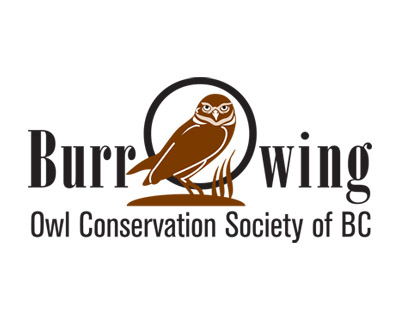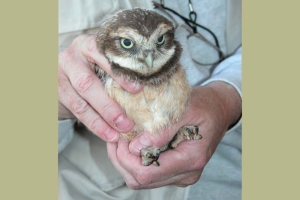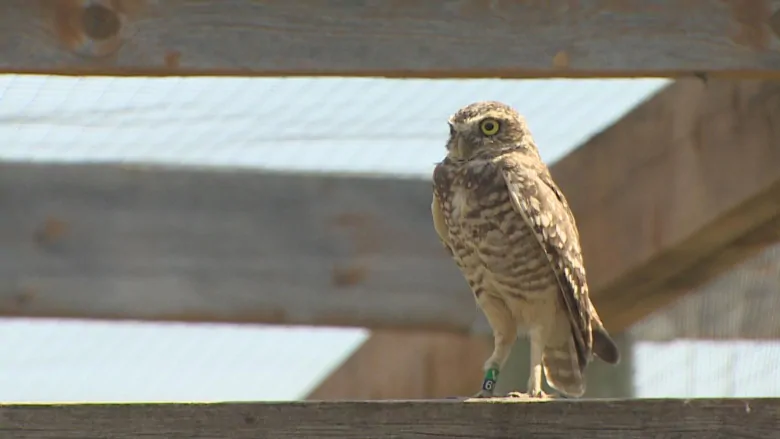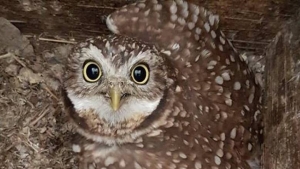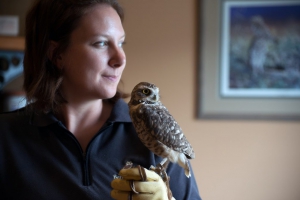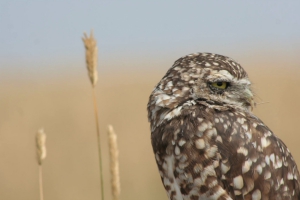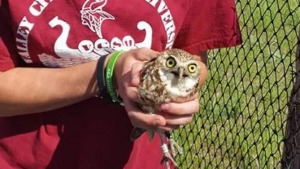BOCS struggling as food costs are doubling to feed endangered species they care for in Oliver
Price hikes for food are hitting everyone’s wallets, including the Burrowing Owl Conservation Society of BC, which is trying to help the tiny endangered species flourish.
Executive Director Lauren Meads said the society started in the 1980s, which is when burrowing owls were deemed extirpated in the province.
“They're also found in Alberta, Saskatchewan and Manitoba. But all of these populations are declining,” she added.
The society has three facilities across BC, including one in Oliver, one with the BC Wildlife Park in Kamloops and one on the west coast in Langley.
“Between the three of them, we breed about 80 to 100 owls a year. We release them into artificial burrows,” Meads said. “Hopefully, they produce young, and those parents and those young will actually migrate south in the winter. So they head down to California, Mexico.”
One of the issues the society is having now is the cost of food.
“Owls are meat eaters, so they love rodents and insects. Rodents make up about 90 per cent of the biomass that they need to take in. So we primarily feed mice, we used to feed day-old chicks, which are the offshoot of the poultry industry. So it's the males that have been culled.
“Unfortunately, recently, due to issues with the bird flu, our sources for those chicks have diminished.”
Since the price for chicks shot up, the society is forced to feed the owls only mice for the time being, which has also seen a price hike.
“Our mice have gone up in price to about $1.30 to $1.40 each. And each owl requires at least two prey items a day. So about $2.60 per owl, each of our facilities can house between 20 to 40 to 50 owls. So times by that, it is quite a lot of money,” Meads said.
“And then we also need to supplement feed the owls that we release out into the field into the artificial burrows.”
Meads said their costs per year for feeding owls used to be about $20 to $30,000.
“We're expecting that to jump almost 100 per cent in the next coming year. So we're sort of at a crossroads of can we afford to produce as many owls as we've been able to and if you can't put as many out into the wild, you have fewer chances of them migrating and coming back.”
The society feels the owls are a very emblematic species of the grasslands.
“Grasslands all over the world haven't necessarily been a focal ecosystem that people have [said] ‘We need to protect it.’ They usually see grasslands as, ‘Oh, we can build here or we can have agriculture,’” Meads added.
“But here in the Okanagan, we have a very small amount of grasslands that's very precious and to use the burrowing owl as sort of a spokesperson for the preservation of the grasslands. If the grasslands are doing well, burrowing owls do well.”
While the society does receive a small amount of provincial funding through the BC gaming grant, as well as all tasting fees donated from the Burrowing Owl Estate Winery, they still rely on private donations to help keep their work going.
“If people are able to even donate five bucks a month, that will help pay for a couple of owls, for their food for a few days. So even just small amounts will help a lot.”
At this time, breeding their own mice or chicks for food for the owls isn't an option, as the cost to build the proper facility and employ it would be even greater.
“We're in a really exciting time. Right now, we don't have any data yet, but we are embarking on national and international work with the United States on tracking some of these owls,” Meads added.
“We've got more partners, and so it'd be a shame for us to really kind of dwindle on how many we're releasing.”
September 8 2023
See the full story on Castanet
https://www.castanet.net/edition/news-story-445554-87-.htm#445554
Casey Richardson Castanet
Captive breeding only works when animals can go home
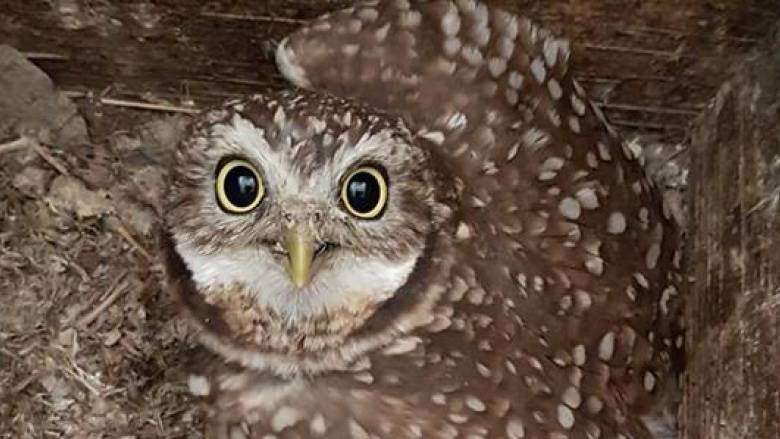
By David Suzuki with contributions from Ontario Science Projects Manager Rachel Plotkin
B.C. is spending hundreds of thousands of dollars on a captive breeding program to protect spotted owls. With an estimated six of the owls left in the wild in Canada, all in B.C., that seems like good news. But while the program includes some habitat protection, the province is also approving logging in habitat the owl needs to survive.
It’s a major flaw in government-led conservation efforts. Stories of captive breeding programs that lead to successful animal re-introduction are happy, but they’re often born out of sad stories about the animals’ plight.
Captive breeding programs are last-ditch efforts to save animals after humans have degraded or destroyed their habitat to the point where it’s difficult for them to survive. In almost every case, experts and regulators are aware of the species’ decline and the reasons behind it, but calls for habitat conservation go unheeded, or efforts are inadequate to ensure the animals can continue.
Species don’t disappear overnight. Activities that degrade and destroy habitat are allowed to continue until a species is driven to point where it can no longer function in the wild and needs human help.
Conservation would work better if land-use management regimes focused on maintaining habitat wildlife needs to survive before it’s too late. Instead, we wait until tipping points have been passed and then scramble to capture animals for breeding.
Nearly 100 juvenile burrowing owls take first steps into the wild
Residents of B.C.'s Interior shouldn't be alarmed if they start seeing a bunch of owls flying around in coming days. It's all part of the plan.
The B.C. Wildlife Park — a zoo in Kamloops, B.C. — has been working for decades to save the native population of burrowing owls from extinction. The park released dozens of the birds into the wild Friday.
It's part of a provincial survival plan to stabilize the animal's declining population.
"Historically, there were owls here, but we like to live exactly where the owls like to live," said Tracy Reynolds, a zookeeper at the park.
"Because of our farms actually taking over their habitat, they've declined to the point of being almost gone."
The park, a member of the Burrowing Owl Conservation Society of B.C., is trying to create livable areas for the creatures, educate the public on their importance and prevent further owl-habitat loss.
For years, the park has been breeding burrowing owls, and then moving them to large, caged enclosures around the Interior as they get older.
First, the animal spends some time flapping around the enclosure, getting used to it. Then, when the time is right, the enclosures are opened and almost 100 of the tagged owls will be free to roam.
The hope is that many of the tagged owls will return to the prepared enclosures in B.C. after they migrate south for the winter.
Read the full article by Matt Humphrey at CBC
Lauren Meads: Top 40 Entrepreneur
This year, Okanagan Edge and the Kelowna Chamber of Commerce have partnered to showcase some of the Okanagan’s most exciting entrepreneurs, through the Top 40 Under 40 program.
This week we recognize Lauren Meads, the executive director of the Burrowing Owl Conservation Society of BC.
Lauren Meads has always been passionate about animals, but became fascinated with animal behaviour and conservation during her university studies.
Meads started volunteering with the Burrowing Owl Conservation Society of BC when she was working on a breeding program for the Northern Spotted Owl.
In 2015 Meads became the field manager for all of the release sites across the province, and this year was named the executive director of the Burrowing Owl Society of BC.
Along with managing breeding activities, Meads works with other volunteers, organizations and local schools.
“This is definitely not your typical job, that you would think has a place in the entrepreneurial world, but it is,” Meads says. “Even with a cute owl by my side I need to convince others of conservation through presentations, fundraising, grant writing and media.”
Click here for the full article at Castanet Media
Global Owl Project in Umatilla Oregon
As founder of the Global Owl Project, David Johnson works with 450 people in 65 countries to research, track, and preserve owl habitat.
He runs a multi-partner project at Umatilla Chemical Depot, in Oregon where volunteers are working hard to increase the numbers or burrowing owls.
A female owl that was tagged and released by BOCS BC was identified nesting at the Umatilla site. She has since mated and produced several young owls that are being monitored.
Dave co-operates with the Burrowing Owl Conservation Society of BC to help save this endangered species.
Read more YakTriNews
WildLens Eyes on Conservation
Burrowing Owls (Athene cunicularia) are a small (150-180 g) species of owl that nests in the natural grasslands of North and South America.
They live in burrows that are first constructed by other burrowing mammals; in BC these mammals are usually badgers and ground squirrels. They are the only owl that nests in the ground, hence their name “burrowing.”
When they first establish a burrow, they remodel the inside by kicking out old dirt.
Sadly, these charismatic owls have been disappearing throughout their range over the last 30 years. In Canada they are listed as Red-Listed (meaning endangered), and in British Columbia they were deemed extirpated in the early 1980s.
There are several potential reasons for declines in Burrowing Owl populations: loss of habitat due to land development, loss of prey species (rodents, grasshoppers), possibly due to agriculture spraying; and the loss of burrowing animals (badgers, ground squirrels, marmots) to dig the holes Burrowing Owls live in. These factors combined with climate changes make this a complex multi-level conservation issue.
Read More at Wild Lens Burrowing Owls of BC
Species Spotlight - Burrowing Owl
Common name: Burrowing Owl
Latin name: Athene cunicularia
Status under SARA: Endangered, 2006 COSEWIC assessment: Endangered
Range: Alberta, Saskatchewan, Manitoba
Life Span: three to four years
Size: 23-28 cm tall; weighs 125-185 g
Population Estimate: Fewer than 1,000 pairs in Canada
The Facts
Burrowing Owls often stand upright on their long thin legs so they can see farther out over the flat prairie.
Often, the male will stand watch outside the burrow while the female and her young are underground. If an intruder comes near, the male sounds an alarm call and then tries to lure the intruder away from the nest with a series of short flights. If the intruder continues, the young birds go to the back of the burrow and make a hissing noise that sounds like a rattlesnake.
They leave for their wintering areas in the southeastern United States and Mexico in September, and return to Canada in April.
Grasshoppers and beetles are the favourite foods of the Burrowing Owl. They also eat a few mice, voles, ground squirrels, toads, small birds, and carrion.
Females lay six to twelve white eggs and incubate them for about four weeks. When the nest gets too crowded (after about two weeks), the young move to the entrance of the nest where they stand waiting for the adults to bring them food. About seven to eight weeks after hatching, the young will start to feed themselves.
After the young are active above ground, they may move to other burrows near the burrow in which they were born.
The Story
Burrowing Owls look like little owls on stilts. They are 23-28 cm tall standing on long thin legs. The Burrowing Owl is unlike most owls in many ways: it lives in burrows in the ground, is active during the day, the female is smaller than the male, and its favourite foods are insects.
Burrowing Owls were common summer residents in the southern regions of the prairie provinces and BC until the mid-1900s when modern agriculture practices began. Cultivation of the land for agriculture has severely reduced Burrowing Owl habitat over the years. By 1979, Burrowing Owls were extirpated from BC. Burrowing Owl populations in the prairie provinces continue to decline. Today, it is thought fewer than 1,000 pairs remain in Alberta and Saskatchewan, and on rare occasions in southwestern Manitoba. Occasionally, the owls winter in coastal British Columbia and are seen in Ontario and Quebec during spring.
Burrowing Owls require open areas with low ground cover, existing burrows, and abundant food. They rely on holes in the ground made by ground squirrels, badgers, and foxes in which they make their nests. Unfortunately, some farmers regard these animals as pests and kill them. With declining populations of these mammals, Burrowing Owls are unable to find suitable nesting sites. Furthermore, ground squirrels and foxes are often killed with poison and, when Burrowing Owls feed on their carcasses, they too are poisoned.
Another threat Burrowing Owls face is “Carbofuron,” a pesticide used to kill grasshoppers in farm fields. When Carbofuran is applied in fields and Burrowing Owls eat the poisoned grasshoppers, the insecticide accumulates in the owls’ bodies. Where Carbofuran is used within 50 m of burrows, the affected owls produce 54 percent fewer young than normal.
While many Burrowing Owls migrate to the southern US and Mexico for the winter, researchers have been trying to find out why only half of adult Burrowing Owls come back to their northern breeding grounds each spring, and why a mere six per cent of young owls return to breed in Canada the year after they are born.
What is Being Done
Burrowing Owls are protected in all provinces where they are found – BC, Alberta, Saskatchewan, and Manitoba.
“Operation Burrowing Owl” was established in Saskatchewan in 1987 to encourage landowners to protect the Burrowing Owls’ nesting habitat. By 1994, 534 landowners in Saskatchewan had committed themselves to protecting owl habitats. In Alberta, the program has expanded to include protection for other endangered species, and is called “Operation Grassland Community”. By 1994, about 260 landowners in Alberta had committed to protecting habitats around owl nesting sites, amounting to over 22,000 ha.
In 1992, six Burrowing Owl pairs were reintroduced to the southern interior of British Columbia. As of 1995, an estimated five to ten pairs of Burrowing Owls were living in BC.
In 1994, the Operation Burrowing Owl newsletter was translated into Spanish for Mexican distribution in the hope that protection will be offered to the birds in their wintering areas.
In 1996, a decision was made by the federal government to slowly phase out some of the uses of the insecticide Carbofuran.
In addition, a national Burrowing Owl recovery team, working through Recovery of Nationally Endangered Wildlife (RENEW), approved a recovery plan in 1995 and updated the plan in 2002. The end goal of the plan is to increase Burrowing Owl populations in Canada to levels where they become self-sustaining.
What You Can Do
- Learn more about the Burrowing Owl and its habitat and share this information with your family, friends, and community.
- Support groups and individuals who are working to save the Burrowing Owl.
- Encourage farmers and other landowners not to disturb areas in which Burrowing Owls live. Encourage landowners to use alternatives to pesticides or lower doses of these chemicals.
Read the full article at Nature Canada
She did it for love.
She did it for love: Rare wild owl tries burrowing into Manitoba enclosure to find mate
Researcher says fewer than 5 pairs of burrowing owls left in wild; Manitoba population nearing extirpation
CBC News · Posted: Jun 06, 2018
With files from Janice Grant and Aidan Geary
A small, tenacious owl discovered trying to worm its way into a captive male's enclosure last weekend has found a love connection researchers hope will result in much-needed burrowing owl chicks.
A field assistant with the Manitoba Burrowing Owl Recovery Program was doing a regular check on the program's five captive mating pairs on Sunday when she spotted the wild little owl, apparently doggedly interested in getting inside one of the pens.
"She was trying to push through [chicken wire] with her head, which she wasn't able to do, and then she was digging at the outside of the pen as well. She was using her talons to sort of dig underneath — it wasn't doing too much," said Alex Froese, the program director.
"She was very, very eager and very interested in getting into this pen."
